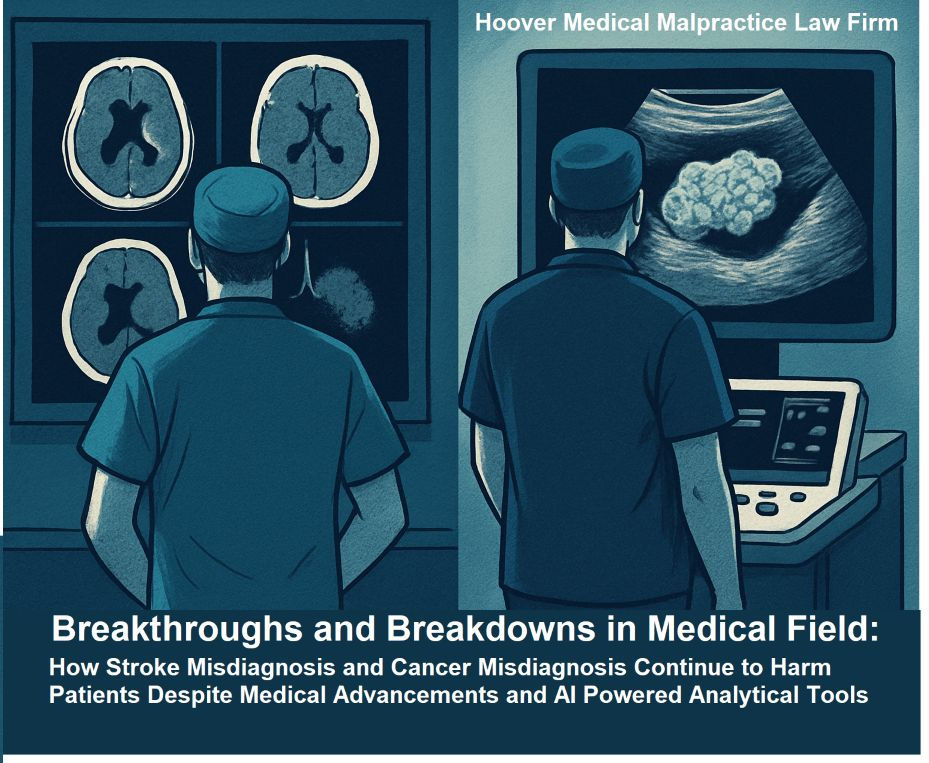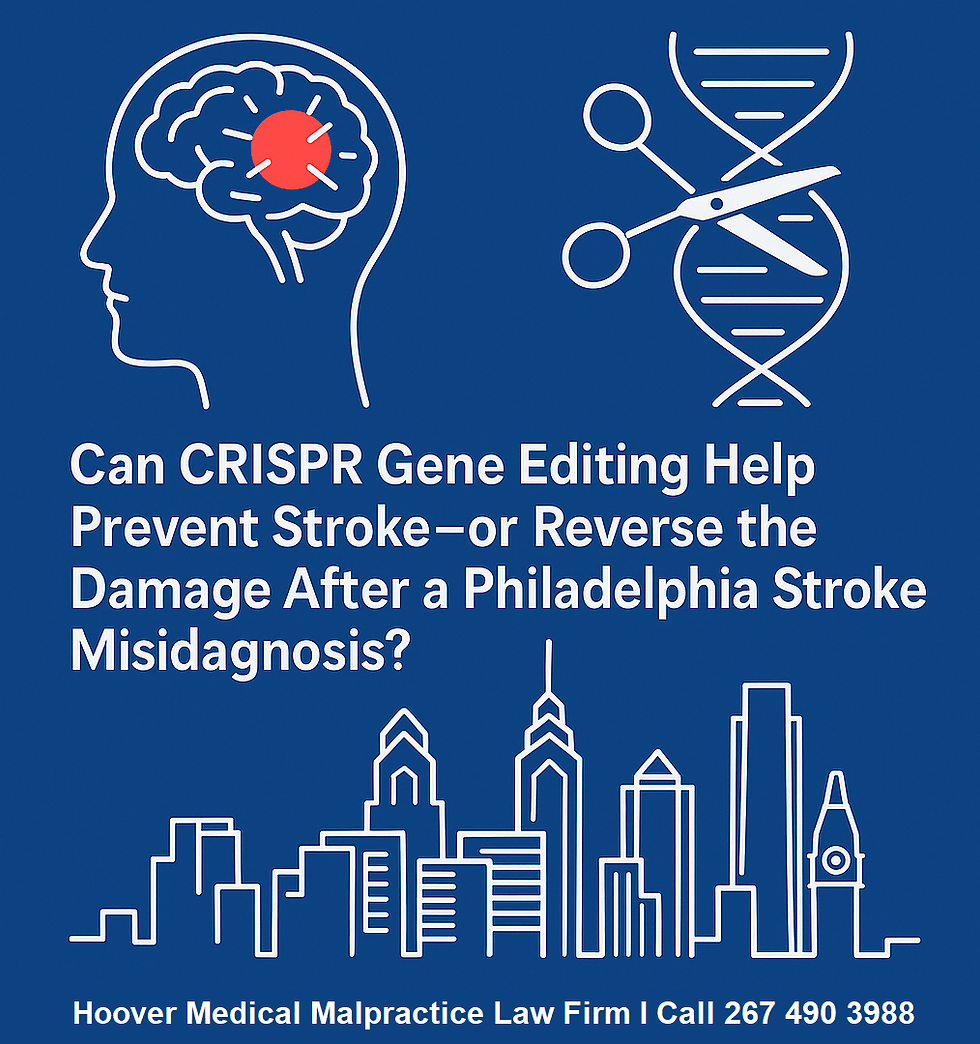Heat Stroke vs. Actual Stroke: How Summer Stroke Misdiagnosis in Philadelphia Emergency Rooms Lead to Tragic Outcomes
- Dave Hoover
- Jul 4, 2025
- 8 min read
Updated: Jul 9, 2025

What You’ll Learn From This Article:
What is the difference between a heat stroke and an actual stroke?Heat stroke is caused by overheating and the body's inability to cool down, while ischemic and hemorrhagic strokes result from blood flow issues in the brain.
Why are stroke misdiagnosis more common in the Summer?Rising temperatures and overlapping symptoms between heat stroke and true strokes increase diagnostic errors in busy Philadelphia emergency rooms.
What are the consequences of Philadelphia stroke misdiagnosis and other Summer-related medical errors?Misdiagnosis can lead to irreversible brain damage, permanent disability, or even death—especially among vulnerable populations like the elderly, pregnant women, and children.
Which cancers and infections spike in summer and are often misdiagnosed?Melanoma, Lyme disease, and certain HPV-related cancers increase during the Summer and can be misdiagnosed or diagnosed too late, leading to worsened outcomes.
Can medical malpractice be proven in cases of heat stroke or Philadelphia stroke misdiagnosis?Yes, especially when doctors ignore symptoms, fail to conduct proper interviews, delay treatment, or skip essential tests—actions that may justify filing a Philadelphia medical malpractice lawsuit.
Introduction: Medical Errors Across Seasona - Why is the Summer Particularly Dangerous
Each season comes with its own set of health hazards and a spike in particular medical emergencies. Spring and Fall, for instance, bring unpredictable weather changes that result in a surge of flus and infections—and with them, an increase in infection misdiagnosis. But Summer presents its own unique medical dangers, driven by rising temperatures, dehydration, and high UV exposure.
In a pivotal U.S. study from 2021, researchers found that the top three most frequently misdiagnosed and severely impactful conditions were:
Stroke
Cancer
Infections
These misdiagnoses are not minor—they are often fatal or cause lifelong complications. Infections like sepsis, meningitis, and necrotizing fasciitis can escalate rapidly without timely intervention. If these infections are overlooked or misclassified in their early stages, irreversible damage or death may occur.
While infections are often perceived as minor ailments like a cold or flu, some infections are medical emergencies requiring immediate recognition and care. Misdiagnosing these can lead to organ failure, brain damage, paralysis, and death.
This article focuses on summer-specific medical dangers, with a spotlight on heat stroke vs. ischemic stroke, how they are commonly confused in ERs across Philadelphia, and how Philadelphia stroke misdiagnosis results in tragic medical outcomes. We will examine who is most at risk, how these errors occur, and what legal options exist for victims and their families.
Types of Strokes and Heat Stroke: Understanding the Medical Landscape
Let’s explore the key types of strokes and why heat stroke often gets confused with them:
1. Ischemic Stroke
This is the most common form of stroke, accounting for about 87% of all cases. It occurs when a blood clot blocks or narrows an artery, reducing blood flow to the brain.
Symptoms: Sudden numbness (especially on one side of the body), confusion, vision problems, difficulty walking.
Risk Factors: Hypertension, diabetes, obesity, smoking, heart disease.
Treatment: Time-sensitive; usually involves thrombolytic therapy (tPA) or mechanical clot removal.
2. Hemorrhagic Stroke
This occurs when a weakened blood vessel ruptures and bleeds into the brain.
Symptoms: Severe headache, nausea, loss of consciousness, sudden vision or speech problems.
Risk Factors: High blood pressure, aneurysms, trauma, blood thinners.
Treatment: Emergency surgery, blood pressure control, and neurocritical care.
3. Transient Ischemic Attack (TIA)
Also known as a “mini stroke,” a TIA is a temporary blockage that mimics stroke symptoms but resolves on its own.
Symptoms: Same as ischemic stroke but lasts less than 24 hours.
Risk Factors: Same as ischemic stroke.
Treatment: Must be treated seriously as a warning sign of a major stroke.
4. Heat Stroke
Though it carries the word “stroke,” heat stroke is a different medical condition entirely. It is caused by prolonged heat exposure and a failure of the body’s cooling system.
Symptoms: High body temperature, confusion, dizziness, flushed skin, dry or damp skin, unconsciousness.
Risk Factors: Extreme heat, dehydration, age (very young or very old), medications.
Treatment: Immediate cooling and hydration—this is a true emergency.
Summary of Stroke Data and Risk Groups
Most frequently occurring Philadelphia stroke misdiagnosis: Ischemic stroke, particularly in women and minorities.
Incidence in the U.S. (CDC, 2023): ~795,000 strokes yearly; 610,000 are first-time strokes.
Deaths: ~140,000 stroke-related deaths annually.
Demographics:
Men vs. Women: Women are more likely to die from strokes.
Age: Most common over age 65.
Children & Pregnancy: Rare, but risk increases during pregnancy, especially in the third trimester and postpartum.
Elderly: Highest risk group—heat and stroke susceptibility are amplified.

Is a Heat Stroke Dangerous and Deadly? Yes, heat stroke is dangerous and can be deadly if not treated promptly.
Heat stroke can lead to permanent organ damage, including brain damage, kidney failure, and death. Despite its name, a heat stroke is not a neurological stroke, but the confusion often leads to dangerous ER delays. The term “stroke” refers to the sudden onset and life-threatening nature of the condition, similar to how real strokes manifest.
Both heat stroke and ischemic strokes involve altered consciousness, confusion, and rapid progression, which is why the two are often confused in high-pressure emergency situations.
Medical Errors in Diagnosing Heat Stroke vs. Philadelphia Stroke Misdiagnosis
Philadelphia emergency rooms often become overcrowded during summer months. Overworked doctors may misclassify a stroke as a heat stroke or vice versa, especially in elderly patients who present with dizziness or slurred speech.
Common Philadelphia emergency rooms medical errors include:
Failing to order a CT scan or MRI to rule out a stroke.
Misinterpreting neurological symptoms as heat-related exhaustion.
Delaying critical stroke treatment such as tPA or emergency surgery.
Stroke occurrences by season: Studies show that stroke incidence spikes in summer and winter, peaking in late July and early January. High temperatures can dehydrate patients, thicken blood, raise blood pressure, and create ideal conditions for blood clots or vessel rupture.
Cardiovascular risks in the Summer:
Heart attacks and pulmonary embolisms increase due to dehydration, heat stress, and outdoor exertion.
Elderly and chronically ill patients are especially vulnerable.
Philadelphia Emergency Room Negligence: Heat Stroke vs. Stroke Misdiagnosis Lawsuits
Philadelphia hospitals are legally and ethically required to follow standard medical protocols when diagnosing and treating strokes or heat-related emergencies. When those protocols are ignored, the results can be catastrophic—and legally actionable.
Common Forms of Negligence in Philadelphia Stroke Misdiagnosis Cases
Failure to take a full medical history (ignoring stroke risk factors like hypertension or atrial fibrillation).
Failure to perform neuroimaging (MRI, CT scan) within the critical stroke diagnosis window.
Attributing confusion, slurred speech, or collapse to “heat exhaustion” without ruling out neurological causes.
Delaying or omitting tPA administration (a clot-busting drug effective only if given within 4.5 hours of stroke onset).
Improper triage or discharge—especially in busy ERs overwhelmed with summer-related cases.
Legal Claim Types for Stroke Misdiagnosis in Philadelphia:
Philadelphia Medical Malpractice – When a healthcare provider deviates from the accepted standard of care.
Philadelphia Hospital Negligence – When a hospital system fails due to understaffing, lack of training, or miscommunication.
Philadelphia Wrongful Death – When the misdiagnosis results in a fatal stroke or preventable heat-related death.
Philadelphia Birth Injury Claims – If a stroke during pregnancy or postpartum is ignored, resulting in permanent harm to the mother or infant.
If a Philadelphia hospital fails to diagnose a stroke or misclassifies it as heat stroke, victims may suffer irreversible brain injury, paralysis, or death. These cases often require expert neurologists and ER physicians to testify about the breach of standard care.
What to Do After a Philadelphia Stroke Misdiagnosis
If you or a loved one were harmed by a stroke misdiagnosis, especially during the hot summer months, here’s what to do:
Request Medical Records ImmediatelyObtain all ER notes, imaging, bloodwork, and vital sign data from the hospital or urgent care facility.
Note Timelines and SymptomsWrite down when symptoms began, what was said by medical staff, and any delays in imaging or treatment.
Contact a Philadelphia Stroke Malpractice LawyerTime is critical both in treating strokes and in fling Philadelphia medical malpractice claims. Pennsylvania’s statute of limitations is typically two years, but some exceptions apply under the Philadelphia discovery rule if the patient only recently learned of the misdiagnosis.
Get a Neurological EvaluationIf you are still recovering, make sure a neurologist evaluates any long-term damage caused by delayed treatment.
Other Common Summer Philadelphia Medical Malpractice and Misdiagnosis Cases
Heat stroke and stroke aren’t the only danger. The following conditions frequently lead to Philadelphia medical malpractice lawsuits during summer months:
1. Melanoma - Philadelphia Skin Cancer Misdiagnosis
Often dismissed as harmless moles.
Delayed diagnosis leads to metastasis and wrongful death.
UV exposure in summer increases risk dramatically.
2. Lyme Disease Misdiagnosis
Ticks thrive in Pennsylvania’s wooded and grassy areas.
Early signs (fatigue, headache, rash) are frequently misread as flu or exhaustion.
Untreated Lyme can lead to neurological problems and chronic pain.
3. Sepsis from Untreated Infections
Cellulitis, UTIs, and respiratory infections can rapidly spiral into life-threatening sepsis if not identified.
Sepsis misdiagnosis is more likely in overworked summer ERs.
4. Dehydration-Induced Kidney Failure
Often missed in infants and elderly patients.
Dehydration also increases risk of stroke, cardiac arrest, and heat-related collapse.
5. Pediatric Summer Illnesses
Infants may present with vague symptoms: fussiness, vomiting, or fatigue.
ERs may dismiss these as "normal summer bugs" rather than meningitis, Kawasaki disease, or heat-related seizure.
Pediatric ER negligence and Philadelphia neonatal care units errors are a growing area of legal concern.
Who Is Most at Risk for Heat Stroke or Philadelphia Stroke Misdiagnosis
Certain populations are more vulnerable to summer stroke and heat-related Philadelphia medical negligence:
Risk Group | Why They’re at Higher Risk |
Elderly | Dehydration, limited mobility, preexisting conditions. |
Children | Inability to express symptoms clearly; rapidly deteriorating conditions. |
Pregnant Women | Elevated blood volume and pressure increases stroke risk. |
Black Patients | Higher stroke mortality and often receive less aggressive or delayed care. |
Patients with Obesity or Diabetes | Higher risk of both heat stroke and Philadelphia stroke misdiagnosis. |
Undocumented Immigrants or Uninsured Individuals | May delay ER visits or be dismissed too early. |
In Philadelphia, where heatwaves are growing more intense and healthcare systems are often under strain, these groups are more likely to experience dangerous ER delays or discharge without proper diagnosis.
Can You Sue for a Heat Stroke or Philadelphia Stroke Misdiagnosis?
Yes. If a hospital, doctor, or nurse failed to meet the standard of care and that negligence led to harm or death, you may have grounds for a Philadelphia medical malpractice or wrongful death lawsuit.
To file a successful stroke misdiagnosis claim in Philadelphia, you must typically show:
Doctor-patient relationship existed.
Breach of standard of care occurred (e.g., no imaging, misreading symptoms, ignored risk factors).
The breach directly caused harm (i.e., delayed stroke treatment caused brain damage or Philadelphia stroke misdiagnosis led to disabilities).
Damages resulted (lost income, long-term care needs, or wrongful death).
Call a Philadelphia Medical Malpractice Lawyer Today
If your family has been affected by a misdiagnosed stroke, heat stroke, or other summer emergency in Philadelphia, the Hoover Medical Malpractice Law Firm is here to help. Our experienced Philadelphia personal injury and wrongful death attorneys are ready to review your case, consult medical experts, and fight for the justice you deserve.
We handle cases involving:
Philadelphia Stroke misdiagnosis
Heat stroke negligence
Pediatric ER negligence and NICU Errors
Philadelphia Cancer Misdiagnosis
Sepsis and infection malpractice
We offer free consultations and handle all cases on a contingency fee basis—you pay nothing unless we win your case.
Call us 24/7 at (267) 490-3988 or Contact us online to schedule your free consultation.





Comments